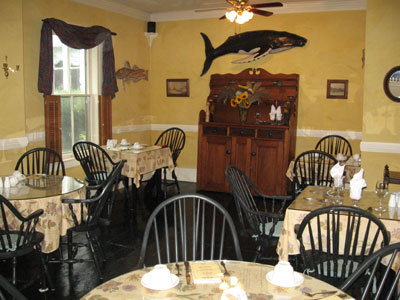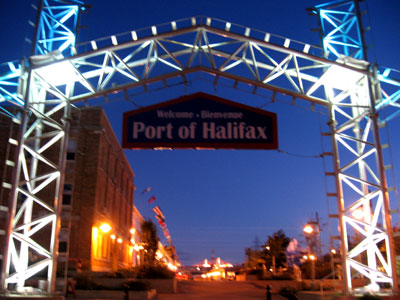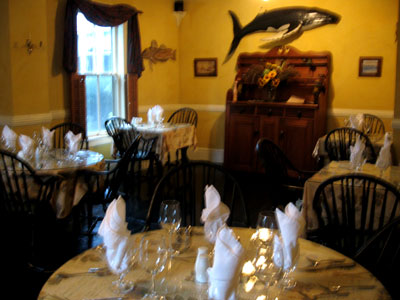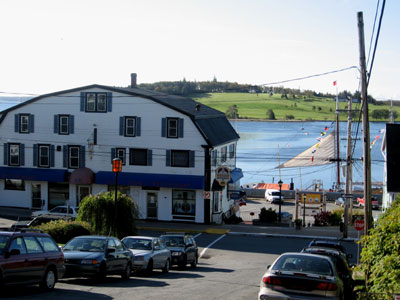Following my introduction to the quaint and historic town of Annapolis Royal I drove about 10 kilometers out of town across the causeway on the north shore of the Annapolis River and arrived in one of the most historic locations in north-eastern North America. Port-Royal is a reconstruction of a settlement – a “Habitation” of French settlers founded in 1605 by Sieur de Mons and Samuel de Champlain and one of the earliest successful European settlement attempts in North America. The settlement existed until 1613 when it was burned to the ground by Captain Samuel Argall of Virginia.
My expert guide for this introduction to early French life in Canada was Wayne Melanson, a ninth generation Acadian and twin brother of Alan Melanson who I had already met at Fort Anne during my initial discoveries of Annapolis Royal. Interestingly, on my drive to Port Royal I noticed a sign saying “Melanson Settlement”, a National Historic Site of Canada which indeed refers to the forefathers of today’s Melanson family. When I connected with Alan and Wayne Melanson, I realized that I had tapped into a piece of living history and was excited to learn more about their story.

The Melanson family goes back to the 17th century
Charles Melanson, the forefather of today’s Melanson family, had come to today’s Annapolis River area with his wife Marie Dugas in about 1664 and settled along the north shore of the river. The Melanson Settlement was an agricultural community employing the Acadian dykeland farming techniques that were unique in the colonies. In 1755 Charles’ son Ambroise and his family were deported from the Annapolis area by the English as part of the Great Expulsion (“le grand derangement”) once this area changed from French to British ownership. Wayne explained that six men, including Ambroise’s son-in-law Pierre Bellieveau initiated a mutiny on the boat and overpowered the crew. Pierre’s son Amand returned to settle in the Clare region in southwestern Nova Scotia.
To this day, some descendants of Charles Melanson are still living right near the original homestead that he founded in the 17th century. Wayne commented that despite this tragic past, people have survived and preserved their cultural identity, a testament to human fortitude and tenacity in the face of adversity. It was amazing to me that after this great diaspora of Acadian settlers in the 18th century two ninth-generation Acadian twin brothers would live and work right next to their ancestors’ original settlement, both bringing history to life for the area’s visitors.

Wayne Melanson, my expert tour guide
Wayne is a presentation supervisor with Parks Canada, the federal agency in charge of many of Canada’s most significant heritage sites, and his appearance reflects the style of dress of early French settlers in the area. He explained to me that today he was dressed in the style of working class people with a simple shirt and pants, covered by a heavy woolen cape against the cold. On his feet he was wearing wooden clogs, a popular piece of footwear at the time.

The entrance gate to the Habitation
We entered the habitation through the wooden gate that features the coat of arms of Henri IV, King of France in 1605 when the original habitation would have been built. The coats of arms of the two governors, Sieur de Mons and Sieur de Poutrincourt, are also represented above the doorway.
The entire Port-Royal complex consists of six attached wooden buildings located around a central courtyard. The buildings were reconstructed from 1939 to 1940 and are a historically accurate replica of the original habitation. This project was a result of the efforts of Harriet Taber Richardson of Cambridge, Massachusetts who raised funds to bring in a Harvard-educated archeologist for the authentic reconstruction of this early French settlement.

Courtyard of the Habitation
The Port-Royal Habitation is an excellent example illustrating the lifestyle and hardships of the early French settlers and fur traders that settled in the eastern part of Canada. Wayne explained that the original settlement held about 30 craftsmen and 15 gentlemen, including a surgeon, a lawyer and a ship’s pilot. No women were residing in Port-Royal.

The Forge
We started our walk at the forge where metal goods were produced on site. The blacksmith was an important member of the community because he produced the hardware needed for the upkeep of the habitation. He also fabricated goods for trade with the Mi’kmaq First Nations People which contributed directly to the settlements financial well-being.

The Common Room, location of many feasts




